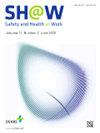Risk for Diabetes From Long Working Hours and Night Work in the United States: Prospective Associations and Machine Learning Techniques
IF 2.9
3区 医学
Q1 PUBLIC, ENVIRONMENTAL & OCCUPATIONAL HEALTH
引用次数: 0
Abstract
Background
Diabetes contributes significantly to death in the U.S., with many working-age individuals affected. This research determined the independent and joint associations of long working hours and night work with diabetes risk in U.S. workers, and their contribution to risk prediction.
Methods
This prospective study included 1,454 workers from the Midlife in the United States (MIDUS) study with 9-year follow-up. Long working hours included those working 55 or more hours per week. Night work involved those working 16 or more nights per year. Diabetes was determined by self-reported diagnosis or treatment. Multivariable Poisson regression analysis was applied to examine the prospective association of these work-related factors at baseline with incident diabetes. A gradient boosting machine learning model was used to investigate the contributions of both factors in predicting incident diabetes.
Results
Long working hours (RR and 95% CI = 1.60 [1.04, 2.46], p < 0.05) and night work (RR and 95% CI = 1.66 [1.05, 2.62], p < 0.05) were independently associated with the risk for diabetes, while controlling for baseline covariates. Gradient boosting analysis suggested long working hours and night work facilitated diabetes incidence. Exposure to both long working hours and night work increased the risk for diabetes (RR and 95% CI = 3.02 [1.64, 5.58], p < 0.001), suggesting additive interaction.
Conclusion
Organizations may consider reducing hours on duty and improving shift systems for primary prevention of diabetes.
在美国,长时间工作和夜间工作对糖尿病的风险:前瞻性关联和机器学习技术
在美国,糖尿病是导致死亡的重要因素,许多工作年龄的人都受到影响。这项研究确定了长时间工作和夜间工作与美国工人糖尿病风险的独立和联合关联,以及它们对风险预测的贡献。方法本前瞻性研究纳入1454名来自美国中年(MIDUS)研究的工人,随访9年。长时间工作包括每周工作55小时或以上的人。夜班是指每年工作16个或以上的人。糖尿病通过自我报告的诊断或治疗来确定。应用多变量泊松回归分析来检验这些工作相关因素在基线时与糖尿病发生的前瞻性关联。使用梯度增强机器学习模型来研究这两个因素在预测糖尿病发病率方面的贡献。结果长时间工作(RR和95% CI = 1.60 [1.04, 2.46], p < 0.05)和夜间工作(RR和95% CI = 1.66 [1.05, 2.62], p < 0.05)与糖尿病风险独立相关,同时控制基线协变量。梯度增强分析表明,长时间工作和夜间工作有利于糖尿病的发生。长时间工作和夜间工作增加了患糖尿病的风险(RR和95% CI = 3.02 [1.64, 5.58], p < 0.001),表明两者相互作用。结论机构可考虑减少值班时间和改进轮班制度以预防糖尿病。
本文章由计算机程序翻译,如有差异,请以英文原文为准。
求助全文
约1分钟内获得全文
求助全文
来源期刊

Safety and Health at Work
Social Sciences-Safety Research
CiteScore
6.40
自引率
5.70%
发文量
1080
审稿时长
38 days
期刊介绍:
Safety and Health at Work (SH@W) is an international, peer-reviewed, interdisciplinary journal published quarterly in English beginning in 2010. The journal is aimed at providing grounds for the exchange of ideas and data developed through research experience in the broad field of occupational health and safety. Articles may deal with scientific research to improve workers'' health and safety by eliminating occupational accidents and diseases, pursuing a better working life, and creating a safe and comfortable working environment. The journal focuses primarily on original articles across the whole scope of occupational health and safety, but also welcomes up-to-date review papers and short communications and commentaries on urgent issues and case studies on unique epidemiological survey, methods of accident investigation, and analysis. High priority will be given to articles on occupational epidemiology, medicine, hygiene, toxicology, nursing and health services, work safety, ergonomics, work organization, engineering of safety (mechanical, electrical, chemical, and construction), safety management and policy, and studies related to economic evaluation and its social policy and organizational aspects. Its abbreviated title is Saf Health Work.
 求助内容:
求助内容: 应助结果提醒方式:
应助结果提醒方式:


